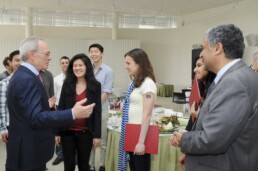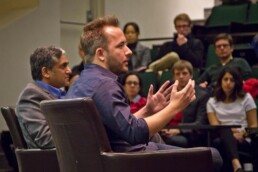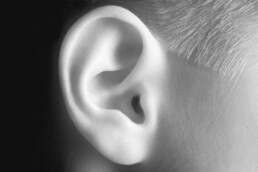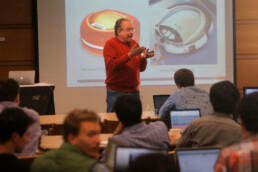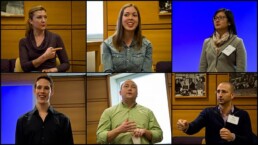EECS undergrads shine at SuperUROP research review
In its third year, SuperUROP is having a positive impact.
Faculty, students, and industry representatives packed MIT’s Grier Room on Thursday, Dec. 4, to learn about new research in robotics, machine learning, wireless power transfer, synthetic biology, and more — all being conducted by undergraduates through the groundbreaking SuperUROP program within the Department of Electrical Engineering and Computer Science (EECS).
“My feeling is some of this work is as good as master’s-quality research. It’s very good stuff,” said Vincent Chan, the Joan and Irwin M. Jacobs Professor of Electrical Engineering and Aeronautics and Astronautics, who is advising two SuperUROP students this year.
Advanced research gives EECS undergraduates the ‘big picture’
SuperUROP connects student creativity with tough challenges
What do you do when you’ve just completed your first deep dive into advanced electrical engineering and computer science research at MIT? Head confidently to graduate school? Get recruited by a prominent tech company? Launch a startup? Yes, yes, and yes. First, though, you celebrate.
More than 70 EECS majors recently commemorated their completion of the Advanced Undergraduate Research Opportunities Program, or SuperUROP, at a festive reception in the Media Lab’s Skyline Room. They spent the past year working several hours per week alongside faculty, postdoctoral associates, and PhD students on projects in areas ranging from artificial intelligence to biologically based computation to nanoengineered optical networks.
Drew Houston and Bob Langer encourage Start6 students at completion of IAP workshop
Start6, the new Department of Electrical Engineering and Computer Science (EECS) IAP workshop for immersion in innovation and entrepreneurship, wrapped up its third week with sendoffs from two icons in the world of startups: Drew Houston ’05, cofounder and CEO of Dropbox, and Institute Professor Bob Langer.
Houston joined Anantha Chandrakasan, EECS department head and creator of Start6, for a fireside chat on Jan. 27. A crowd of interested students from across campus came to hear Houston describe his experiences and offer advice on taking the plunge to launch a startup.
Cochlear implants — with no exterior hardware
A cochlear implant that can be wirelessly recharged would use the natural microphone of the middle ear rather than a skull-mounted sensor.
Cochlear implants — medical devices that electrically stimulate the auditory nerve — have granted at least limited hearing to hundreds of thousands of people worldwide who otherwise would be totally deaf. Existing versions of the device, however, require that a disk-shaped transmitter about an inch in diameter be affixed to the skull, with a wire snaking down to a joint microphone and power source that looks like an oversized hearing aid around the patient’s ear.
Researchers at MIT’s Microsystems Technology Laboratory (MTL), together with physicians from Harvard Medical School and the Massachusetts Eye and Ear Infirmary (MEEI), have developed a new, low-power signal-processing chip that could lead to a cochlear implant that requires no external hardware. The implant would be wirelessly recharged and would run for about eight hours on each charge.
MIT retools to aid students with startups
Is it possible MIT is feeling inadequate — insecure even?
That seems hard to imagine for the school that helped invent the transistor radio, radar, Technicolor, modern robotics, and essentially the field of biotechnology, and whose famous graduates include a Treasury secretary, Israeli prime minister, an astronaut who walked on the moon, and dozens of Nobel Prize winners.
But the Massachusetts Institute of Technology is facing increasing competition from around the corner and across the country.
Its neighbor, Harvard University, is building an innovation campus and business park in Allston to rival MIT’s backyard in Kendall Square. And in Silicon Valley, Stanford University has emerged as the center of gravity for this exciting new era, in which seemingly every other bright young student is starting a new company, and more than a few of them are becoming overnight millionaires.
Start6 inspires student engineers to become entrepreneurs
In Start6, a new entrepreneurship program for MIT engineering students offered during IAP, participants have received advice from such guest speakers as Paul English, cofounder of Kayak; Mike Evans ’99, MEng ’00, and COO and cofounder of GrubHub; Marina Hatsopoulos ’92, serial entrepreneur, former CEO and director of Z Corporation, and angel investor; and Max Krohn ’08, cofounder of OkCupid. And that was just on the first day.
The three-week workshop, which began Jan. 13, also features visits from Drew Houston ’05, CEO and cofounder of Dropbox; Google vice president Jeremy Wertheimer ’89, former CEO of ITA Software; Nanxi Liu, a 23-year-old who has already founded two successful startups; Rodney Brooks, founder, chairman, and CTO of Rethink Robotics and Panasonic Professor of Robotics (emeritus) at MIT; Ray Stata ’57, cofounder of Analog Devices; and Robert Langer, prolific inventor and entrepreneur and the David H. Koch Institute Professor at MIT. In addition, venture capitalists Peter Levine of Andreessen Horowitz and Jamie Goldstein ’89 of North Bridge Venture Partners walked the Start6 students through the various phases of a startup.

